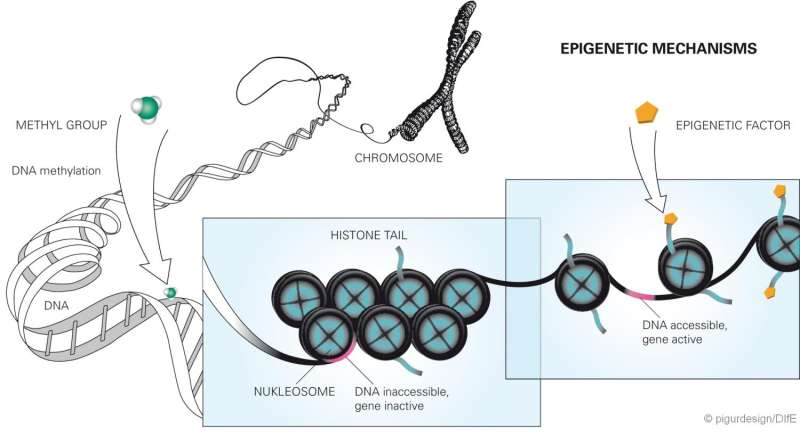Epigenetic modification increases susceptibility to obesity and predicts fatty liver

Scientists of the German Center for Diabetes Research (DZD), led by the German Institute of Human Nutrition (DIfE), have demonstrated that the epigenetic modification of the Igfbp2 gene observed in young mice precedes fatty liver in adulthood. In addition, young animals with this modification exhibit impaired glucose metabolism and are significantly more prone to morbid obesity. Annette Schürmann of DIfE said, "In morbidly obese people with incipient diabetes, we were able to demonstrate this modification in the corresponding gene. In the future, it may potentially be used as a risk marker."
The researchers led by study director Annette Schürmann, Robert Schwenk and Anne Kammel of DIfE, recently published their findings in the journal Human Molecular Genetics.
According to the World Health Organization, the number of obese people has risen to over a half-billion worldwide and will continue to increase in the future. This trend is worrying, because obesity increases the risk of type 2 diabetes, non-alcoholic fatty liver disease, heart attack, stroke and certain cancers. Nevertheless, not every person is equally prone to obesity and its sequelae—family background also influences individual obesity risk. However, the gene variants identified thus far explain only about 5 percent of the familial predisposition. This discrepancy suggests that other hereditary factors also play a role, such as epigenetic changes in the genetic material, including DNA methylation. These epigenetic modifications do not change the genetic code, but may contribute to the inhibition of gene expression, causing the cells to produce smaller amounts of the corresponding proteins. This can lead to metabolic disorders, among other disturbances.
Already in 2013, a research team from Dresden showed that people who suffer from type 2 diabetes and fatty liver produce lower amounts of the protein IGFBP2 in the liver. At the same time, the group demonstrated that the reduced IGFBP2 secretion is accompanied by an increased rate of DNA methylation of various genes. In order to determine the extent to which the reduced protein secretion is due to epigenetic changes, the researchers led by Annette Schürmann studied the associations in a mouse model, the so-called C57BL/6J mouse.
Similar to identical twins, all animals of this strain were genetically identical. Nevertheless, some mice gained much more weight than others when given a high-fat diet and subsequently developed a fatty liver. As the researchers showed, at the age of six weeks, the Igfbp2 gene already exhibited higher levels of methylation, i.e. stronger epigenetic modification. At the same time, the IGFBP2 synthesis in the liver was significantly reduced. Furthermore, these mice showed the first disturbances in the glucose metabolism very early. Further molecular biological studies by the scientists demonstrated that methylation in the non-coding region of the Igfbp2 gene contributes to less IGFBP2 synthesis. Moreover, in human blood cells of people suffering from morbid obesity and whose glucose metabolism was already disturbed, the researchers detected the same epigenetic modification in the human gene.
"Our results indicate that the epigenetic modification we studied makes both mice and humans more susceptible to obesity and with increasing age increases their risk of developing a fatty liver," said Anne Kammel, first author of the study. Schürmann added: "Since methylation of the gene occurs very early, well before a fatty liver has developed, it would be conceivable to use this knowledge to better assess the disease risk in adolescents and young adults. With appropriate measures, the disease could thus be prevented in time."
More information: Anne Kammel et al, Early hypermethylation of hepaticresults in its reduced expression preceding fatty liver in mice, Human Molecular Genetics (2016). DOI: 10.1093/hmg/ddw121


















